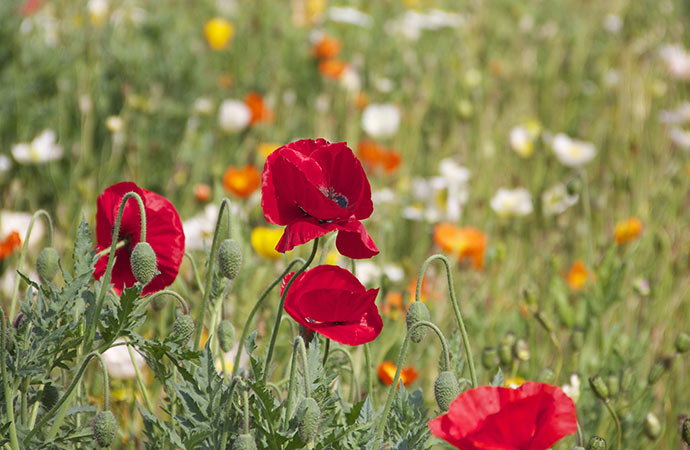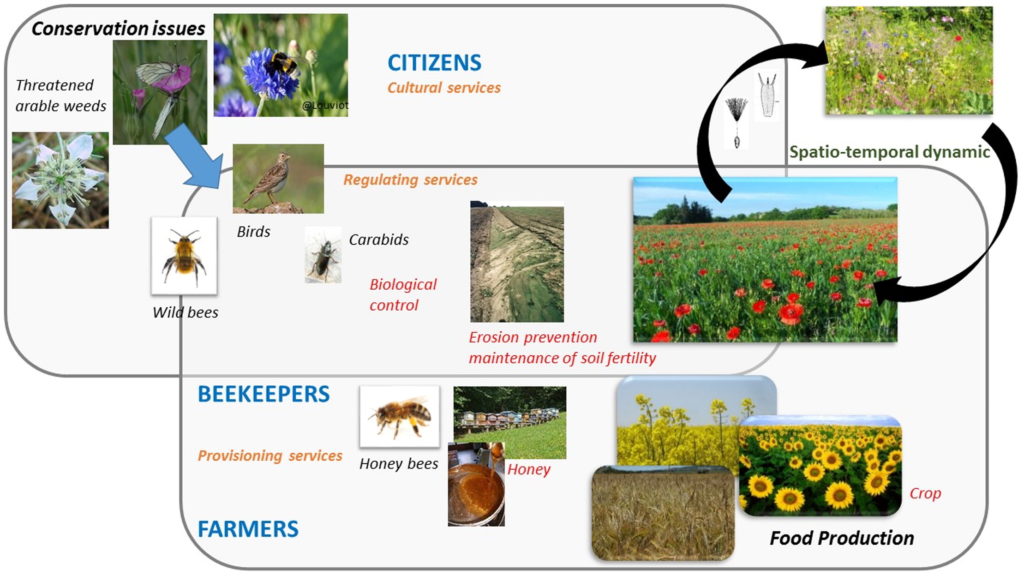DISCO-WEED
Disentangling the role of anthropic disturbances and ecological processes on weed community assembly

Weeds are an important threat to crop production and management rules have been developed to regulate weeds in fields. However, intensive use of herbicides and inorganic fertilizers, large-scale simplification of crop sequences and repeated ploughing has caused considerable biodiversity loss in European agro-ecosystems; many weed species are currently threatened with extinction. Moreover, the drastic decline observed in weed diversity and abundance has highlighted the crucial functional role weeds play in agroecosystem food-webs; including in pollination, provision of habitat and biological control.
The recognition of the need to better balance food production with other, non-provisioning ecosystem services, is reflected in the 2014-2020 reform of the Common Agricultural Policy which, for the first time includes ‘greening measures’ as a requirement for Pillar 1 payments (i.e. direct income support payments to farmers) that primarily support agricultural productivity. Assuring food security and conserving farmland biodiversity while reducing chemical inputs has also been the motivation for a number of National initiatives (e.g. French Ecophyto Plan, Campaign for the Farmed Environment in the UK). In this context, it is imperative that the consequences of agricultural management on weed abundance and crop production are investigated.
The Disco-Weed project addresses these challenges using an interdisciplinary approach and fills the knowledge gap to reducing chemical inputs and understanding the effects of weeds on crop production.

Schematic representation of the key role of weeds in agroecosystems (Gaba et al., 2016)

PI:
Sabrina GABA – INRAE (Dijon, France)
Postdoc:
Bérenger BOURGEOIS – INRAE (Dijon, France)
DiscoWeed brings together ecologists, agronomists and statisticians.
DISCO-WEED was selected from the 2014 call for proposals. The project selection process was carried out by a committee of independent experts.
[13] Fried G, Armengot L, Storkey J, Bourgeois B, Gaba S, Violle C & Munoz F (2021) Do ecological specialization and functional traits explain the abundance-frequency relationship? Arable weeds as a case study. Journal of Biogeography, 48, 37–50. DOI: 10.1111/jbi.13980.
[12] Bourgeois B, Gaba S, Plumejeaud C & Bretagnolle V (2020) Weed diversity is driven by complex interplay between multi-scale dispersal and local filtering. Proceedings of the Royal Society B: Biological Sciences, 287, 20201118. DOI: 10.1098/rspb.2020.1118.
[11] Gaba S, Cheviron N, Perrot T, Piutti S, Gautier J-L & Bretagnolle V (2020) Weeds enhance multifunctionality in arable lands in South-West of France. Frontiers in Sustainable Food Systems, 4, 71. DOI: 10.3389/fsufs.2020.00071.
[10] Mahaut L, Cheptou P-O, Fried G, Munoz F, Storkey J, Vasseur F, Violle C & Bretagnolle V (2020) Weeds: Against the rules? Trends in Plant Science, 25, 1107–1116. DOI: 10.1016/j.tplants.2020.05.013.
[09] Munoz F, Fried G, Armengot L, Bourgeois B, Bretagnolle V, Chadoeuf J, Mahaut L, Plumejeaud C, Storkey J, Violle C & Gaba S (2020) Ecological specialization and rarity of arable weeds: Insights from a comprehensible survey in France. Plants, 9, 824. DOI: 10.3390/plants9070824.
[08] Bourgeois B, Munoz F, Fried G, Mahaut L, Armengot L, Denelle P, Storkey J, Gaba S & Violle C (2019) What makes a weed a weed? A large-scale evaluation of arable weeds through a functional lens. American Journal of Botany, 106, 90–100. DOI: 10.1002/ajb2.1213.
[07] Catarino R, Gaba S & Bretagnolle V (2019) Experimental and empirical evidence shows that reducing weed control in winter cereal fields is a viable strategy for farmers. Scientific Reports, 9, 9004. DOI: 10.1038/s41598-019-45315-8.
[06] Mahaut L, Gaba S & Fried G (2019) A functional diversity approach of crop sequences reveals that weed diversity and abundance show different responses to environmental variability. Journal of Applied Ecology, 56, 1400–1409. DOI: 10.1111/1365-2664.13389.
[05] Metcalfe H, Hassall KL, Boinot S & Storkey J (2019) The contribution of spatial mass effects to plant diversity in arable fields. Journal of Applied Ecology, 56, 1560–1574. DOI: 10.1111/1365-2664.13414.
[04] Gaba S, Caneill J, Nicolardot B, Perronne R & Bretagnolle V (2018) Crop competition in winter wheat has a higher potential than farming practices to regulate weeds. Ecosphere, 9, e02413. DOI: 10.1002/ecs2.2413.
[03] Storkey J & Neve P (2018) What good is weed diversity? Weed Research, 58, 239–243. DOI: 10.1111/wre.12310.
[02] Munoz F, Fried G, Armengot L, Bourgeois B, Bretagnolle V, Chadoeuf J, Mahaut L, Plumejeaud C, Storkey J, Violle C & Gaba S (2017) Database of weeds in cultivation fields of France and UK, with ecological and biogeographical information (Version 1.0.0) [Data set], Zenodo. DOI: 10.5281/zenodo.1112342.
[01] Gaba S, Reboud X & Fried G (2016) Agroecology and conservation of weed diversity in agricultural lands. Botany Letters, 163, 351–354. DOI: 10.1080/23818107.2016.1236290.
> Bourgeois B, Gaba S, Plumejeaud C & Bretagnolle V (2020) Weed diversity is driven by complex interplay between multi-scale dispersal and local filtering. Proceedings of the Royal Society B: Biological Sciences, 287, 20201118. doi: 10.1098/rspb.2020.1118.
> Gaba S, Cheviron N, Perrot T, Piutti S, Gautier J-L & Bretagnolle V (2020) Weeds enhance multifunctionality in arable lands in South-West of France. Frontiers in Sustainable Food Systems, 4, 71. doi: 10.3389/fsufs.2020.00071.